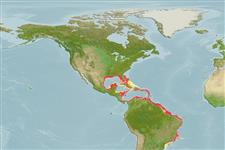>
Eupercaria/misc (Various families in series Eupercaria) >
Haemulidae (Grunts) > Haemulinae
Etymology: Conodon: Latin, conicus = cone + Greek, odous = teeth (Ref. 45335).
More on author: Linnaeus.
Environment: milieu / climate zone / profondeur / distribution range
Écologie
marin démersal; profondeur 1 - 100 m (Ref. 9626). Subtropical; 30°N - 33°S, 99°W - 30°W
Western Atlantic: Texas and eastern Florida (USA) and Jamaica to Brazil. Including western Gulf of Mexico, Puerto Rico, Lesser Antilles, Central and South American coasts (Ref. 26938). Also found in Argentina (Ref. 86320).
Length at first maturity / Taille / Poids / Âge
Maturité: Lm 20.8 range ? - ? cm
Max length : 31.2 cm TL mâle / non sexé; (Ref. 127568); 35.4 cm TL (female); common length : 25.0 cm TL mâle / non sexé; (Ref. 5217); poids max. publié: 411.20 g (Ref. 127568); poids max. publié: 411.20 g
Épines dorsales (Total) : 12; Rayons mous dorsaux (Total) : 13; Épines anales: 3; Rayons mous anaux: 7.
Body shape (shape guide): fusiform / normal.
Found along sandy shores and over shallow muddy bottoms (Ref. 3798). Adults feed at night on crustaceans and small fishes (Ref. 3798). Marketed fresh (Ref. 3798).
Distinct pairing during breeding (Ref. 205).
Robins, C.R. and G.C. Ray, 1986. A field guide to Atlantic coast fishes of North America. Houghton Mifflin Company, Boston, U.S.A. 354 p. (Ref. 7251)
Statut dans la liste rouge de l'IUCN (Ref. 130435: Version 2025-1)
Menace pour l'homme
Harmless
Utilisations par l'homme
Pêcheries: commercial; Aquarium: Aquariums publics
Outils
Articles particuliers
Télécharger en XML
Sources Internet
Estimates based on models
Preferred temperature (Réf.
123201): 23.7 - 28, mean 26.7 °C (based on 408 cells).
Phylogenetic diversity index (Réf.
82804): PD
50 = 0.6250 [Uniqueness, from 0.5 = low to 2.0 = high].
Bayesian length-weight: a=0.01288 (0.01123 - 0.01478), b=3.00 (2.96 - 3.04), in cm total length, based on LWR estimates for this species (Ref.
93245).
Niveau trophique (Réf.
69278): 3.6 ±0.3 se; based on diet studies.
Generation time: 2.3 ( na - na) years. Estimated as median ln(3)/K based on 1
growth studies.
Résilience (Réf.
120179): Milieu, temps minimum de doublement de population : 1,4 à 4,4 années (Assuming tm=2).
Fishing Vulnerability (Ref.
59153): Low to moderate vulnerability (27 of 100).
🛈
Climate Vulnerability (Ref.
125649): High vulnerability (55 of 100).
🛈
Nutrients (Ref.
124155): Calcium = 99.9 [20.7, 207.9] mg/100g; Iron = 1.2 [0.6, 2.3] mg/100g; Protein = 19.3 [17.4, 21.1] %; Omega3 = 0.376 [0.205, 0.643] g/100g; Selenium = 26.4 [14.2, 50.6] μg/100g; VitaminA = 12.3 [4.7, 30.6] μg/100g; Zinc = 0.766 [0.539, 1.125] mg/100g (wet weight);
